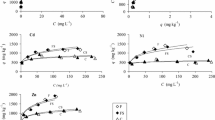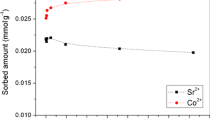Abstract
Sorption of heavy metal (copper and strontium) ions by the meadow chernozem and grey forest soils differing in the content of organic substance was described using the Langmuir equation. The analysis of characteristic sorption coefficients demonstrated that copper possesses the enhanced affinity for the studied soil samples compared to strontium. Maximal values of the sorption of copper (0.085 mmol/g) and strontium (0.045 mmol/g) obtained for the colloidal fraction of meadow chernozem soil (particle diameter d < 1 μm) are approximately 1.5 times larger than for the same fraction of grey forest soil; this ratio remains almost the same even when using the coarser fraction (d < 50 μm). It was established that up to 90% of metal ions could be present in the soil in an immobile form. An increase in the concentration of heavy metal ions in the soil causes their redistribution between the components of absorbing soil complex and an increase in the fraction of metal in mobile forms (water-soluble, exchange, soluble in weakly acidic medium). Upon the microbiological treatment (bioleaching in the suspension variant) of the soils containing copper or strontium ions, the total content of metal, including its mobile forms, decreases by an order of magnitude.
Similar content being viewed by others
REFERENCES
Zhovinskii, E.Ya. and Kuraeva, I.V., Geokhimiya tyazhelykh metallov v pochvakh Ukrainy(Geochemistry of Heavy Metals in Ukrainian Soils), Kiev: Naukova Dumka, 2002.
Ladonin, D.V., Pochvovedenie, 2002, no. 1, p. 682.
Orlov, D.S., Khimiya pochv(Chemistry of Soils), Moscow: Mosk. Gos. Univ., 1992.
Tessier, A., Cambell, P.G., and Bisson, M., Anal. Chem.,1979, vol. 51, p. 844.
Diels, L., De Smet, M., and Hooyberghy, L., Mol. Biotechnol., 1999, vol. 12, p. 149.
Gomez, C. and Bosesecker, K., Geomicrobiol. J., 1999, vol. 16, p. 233.
Matsumoto, S., Soil Sci. Plant Nutr. (Tokyo), 1999, vol. 45, p. 237.
Nikovskaya, G.N., Ul'berg, Z.R., and Koval', L.A., Kolloidn. Zh., 2001, vol. 63, p. 820.
Praktikum po pochvovedeniyu(Laboratory Manual of Soil Science), Kaurichev, I.S., Ed., Moscow: Agropromizdat, 1986.
Britske, M.E., Atomno-absorbtsionnyi spektrokhimicheskii analiz(Atomic Absorption Spectral Analysis), Moscow: Khimiya, 1982.
Voyutskii, S.S., Kurs kolloidnoi khimii(Textbook of Colloid Chemistry), Moscow: Khimiya, 1975.
Kuznetsov, V.A. and Shimko, G.A., Metod postadiinykh vytyazhek pri geokhimicheskikh issledovaniyakh(The Method of Fractionated Extraction in Geochemical Studies), Minsk: Nauka i Tekhnika, 1990.
Birsh, J. and Bachofen, R., Experientia, 1990, vol. 46, p. 827.
Aristovskaya, T.V., Mikrobiologiya protsessov pochvoobrazovaniya(Microbiology of Soil Formation Processes), Leningrad: Nauka, 1980.
Matveeva, L.A., Kora vyvetrivaniya(Weathering Crust), Moscow: Nauka, 1968, no. 10, p. 234.
Lur'e, Yu.Yu., Spravochnik po analiticheskoi khimii(Handbook of Analytical Chemistry), Moscow: Khimiya, 1971.
Author information
Authors and Affiliations
Rights and permissions
About this article
Cite this article
Nikovskaya, G.N., Ul'berg, Z.R. & Borisova, E.N. Sorption–Desorption of Copper and Strontium Ions by the Soil. The Influence of Microorganisms on the State of Metals. Colloid Journal 66, 451–455 (2004). https://doi.org/10.1023/B:COLL.0000037452.05975.f5
Issue Date:
DOI: https://doi.org/10.1023/B:COLL.0000037452.05975.f5




